This course really has given me a great opportunity to be open-minded and see technology from a broader sense, which was that almost everything involved in our daily life is the product of the advanced technology. Techonology has brought us so many possibilities in our life and definitely has made our life easier in a lot of ways. For example, the blog. Through blogging with each other, we could easily read each other's mind and have access to lots of meaningful intereactions and information.
In early childhood field, we are teaching our next generation. We should be more aware of the importance of technology that it's playing in children's life. Children are the nation's hope and the world's hope. If they don't learn to adapt and innovate, they would be failed late on in the near feture as the whole nation requies people to be skilled and educated. "New Zealand is part of a world revolution in communication, technology, work, and leisure. Change in these and other spheres is a feature of everyday life" (Ministry of Education, 1996, p.18).
New Zealand needs its young people to be able to contribute fully to its well-being, and able to meet the changing needs of the workplace and the economy (Fleer & Marilyn, 1997).
Technology is a field of human activity and children should be able to know it and have access to it form a variety of contexts (Fisher & Garvey, 1992). Technology as a perespective or thread that can be emphasised in any early childhood learning experience or activity (Haugland & Wright, 1997). The previous four blogs that I have posted all showed and outlined the importance of technology in children's learning and development. They all hightlighted that technology played a role as thread to help children gain more meaningful and valueable learning experiences later on. Some of my classmates also shared thoughtful suggestions with me to follow up and to further children's learning. I really appreciated that as it was mutual learning through technology. We are all here to support each other and to help our next generation to benefit more.
The learning outcomes of this course are really great as I feel that I start seeing things in a broader sense, having a more open mindset and making me think more. Through blogging with each other, we talked and discussed meaningful issues which has happened and will be happening in our daily life.
As a learner myself, my ideas about technology are still developing, and I expect they will change as I continue to reflect on what is happening for our children as we explore technology all togetehr in our setting.
References:
Fisher, R. & Garvey, J., (1992). Investing technology. Great Britian: Simon and Schuster Education.
Fleer, M. (1997). The Technical Language Children Use At Home. Early Childhood Folio. NZCER.
Haugland, S. W. & Wright, J. L. (1997). Young children and technology: A world of discovery. Boston: Allyn & Bacon.
Ministry of Education. (1996). Te Whariki: He Whariki matauranga mo nga mokopuna o Aotearoa. Wellington, New Zealand: Learning Media








